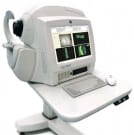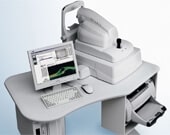 Glaucoma is a group of diseases that can damage the eye’s optic nerve and result in vision loss and blindness. The optic nerve is a bundle of more than 1 million nerve fibers. It connects the retina to the brain. The retina is the light-sensitive tissue at the back of the eye. A healthy optic nerve is necessary for good vision.
Glaucoma is a group of diseases that can damage the eye’s optic nerve and result in vision loss and blindness. The optic nerve is a bundle of more than 1 million nerve fibers. It connects the retina to the brain. The retina is the light-sensitive tissue at the back of the eye. A healthy optic nerve is necessary for good vision.
In the front of the eye is a space called the anterior chamber. A clear fluid flows continuously in and out of the chamber and nourishes nearby tissues. The fluid leaves the chamber at the open angle where the cornea and iris meet. When the fluid reaches the angle, it flows through a spongy meshwork, like a drain, and leaves the eye.
Increased Eye Pressure & Glaucoma Risks
Sometimes, when the fluid reaches the angle, it passes too slowly through the meshwork drain. As the fluid builds up, the pressure inside the eye rises to a level that may damage the optic nerve. When the optic nerve is damaged from increased pressure, open-angle glaucoma–and vision loss–may result. That’s why controlling pressure inside the eye is important.
Increased eye pressure means you are at risk for glaucoma but does not mean you have the disease. A person has glaucoma only if the optic nerve is damaged. If you have increased eye pressure but no damage to the optic nerve, you do not have glaucoma. However, you are at risk. Are you seeking a Cleveland Glaucoma eye doctor for a second opinion? If so please read more about this silent thief in sight.
Who is at Risk for Glaucoma?
Anyone can develop glaucoma. Some people are at higher risk than others. They include:
- People who are diabetic
- African Americans over age 40.
- Everyone over age 60, especially Hispanic Americans.
- People with a family history of glaucoma.
Immediate treatment for early-stage, open-angle glaucoma can delay the progression of the disease. That’s why early diagnosis is very important. A comprehensive dilated eye exam by one of Cleveland Eye Clinic’s eye care professionals can reveal more risk factors, such as high eye pressure, thinness of the cornea, and abnormal optic nerve anatomy. In some people with certain combinations of these high-risk factors, medicines in the form of eyedrops reduce the risk of developing glaucoma by about half.
Types of Glaucoma
Open-angle glaucoma. This is the most common type of glaucoma. The structures of the eye appear normal, but fluid in the eye does not flow properly through the drain of the eye, called the trabecular meshwork.
Angle-closure glaucoma. This type of glaucoma is less common but can cause a sudden buildup of pressure in the eye. Drainage may be poor because the angle between the iris and the cornea (where a drainage channel for the eye is located) is too narrow. Or, the pupil opens too wide, narrowing the angle and blocking the flow of the fluid through that channel.
Glaucoma Treatment Options
Eye Drops for Glaucoma
Glaucoma is typically treated with eye drops that decrease eye pressure either by slowing the amount of fluid produced within the eye or by improving the flow through the drainage angle. Glaucoma medications may produce side effects, so be sure to talk to your doctor if you experience any unusual symptoms.
Direct Selective Laser Trabeculoplasty (Direct SLT)
The Cleveland Eye Clinic Surgeons were the first doctors in Northeast Ohio to offer their patients the Direct SLT technology.
Direct SLT is a minimally invasive laser procedure used to treat glaucoma by lowering intraocular pressure (IOP). During the SLT procedure, a specialized laser is applied to the trabecular meshwork, the drainage system of the eye. This targeted treatment selectively affects pigmented cells within the meshwork, enhancing the outflow of aqueous humor, the fluid inside the eye. Unlike traditional glaucoma surgeries, SLT is typically performed on an outpatient basis and does not require extensive recovery time. Patients often experience a reduction in IOP without the side effects commonly associated with medications. Overall, Direct SLT represents a valuable option in glaucoma management, particularly for patients who may not respond well to pharmacological treatments.
SLT – Selective Laser Trabeculoplasty

Selective Laser Trabeculoplasty (SLT) is quickly becoming a widely accepted treatment option in glaucoma treatment. SLT offers a new glimpse of hope for glaucoma patients. By engaging in this new laser technology, ophthalmologists can now lower pressure that can possibly help a patient avoid a more invasive surgery. The surgery might even reduce the dependence on medications or drops.
Selective Laser Trabeculoplasty (SLT) is an advanced laser system that improves the flow of fluid in the eye, lowering Intraocular pressure (IOP) for patients who have glaucoma. SLT uses short pulses of low energy laser light to target melanin-containing cells in a network of tiny channels, called the trabecular meshwork. The objective of the surgery is to help fluids drain out of the eye, reducing intra-ocular pressure that can cause damage to the optic nerve and loss of vision.
OCT Machine

 The OCT is an innovative and unique diagnostic instrument that is used to process the health of the retina. The retina is tissue in the back of the eye that is responsible for collecting data and transmitting it to your brain for processing. A specialized laser scans and measures the retina. These measurements are then analyzed by a computer and used to create a map of the retina.
The OCT is an innovative and unique diagnostic instrument that is used to process the health of the retina. The retina is tissue in the back of the eye that is responsible for collecting data and transmitting it to your brain for processing. A specialized laser scans and measures the retina. These measurements are then analyzed by a computer and used to create a map of the retina.
The OCT scans the retina and optic nerve with a laser, The OCT is able to process information and measurements taken from the retina, macula, optic nerve and all surrounding retinal tissue. Glaucoma, Macular Degeneration and Diabetes are all diseases that can be monitored with the OCT.
Durysta Implant
The Durysta implant is a new FDA approved dissolvable implant for the treatment of Glaucoma! Once the implant is placed into the eye it slowly releases medication and manages eye pressure for several months.
Click here to learn more about Durysta.
Do you have or think you may have Glaucoma?
Glaucoma is one of the leading causes of blindness and it is very important to have your eye pressure checked during routine eye exams. If you know or suspect you have Glaucoma, schedule an appointment with one of our specialists to discuss treatment options for your vision.








